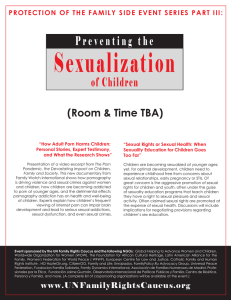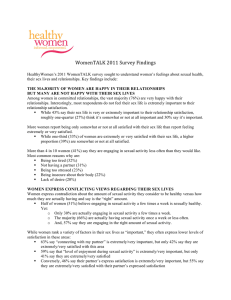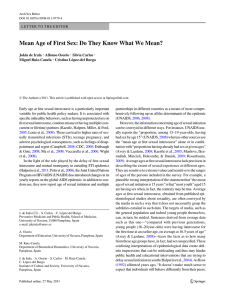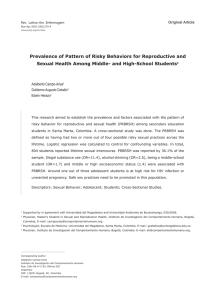Knowledge and attitudes about adolescent sexuality in first course to
Anuncio
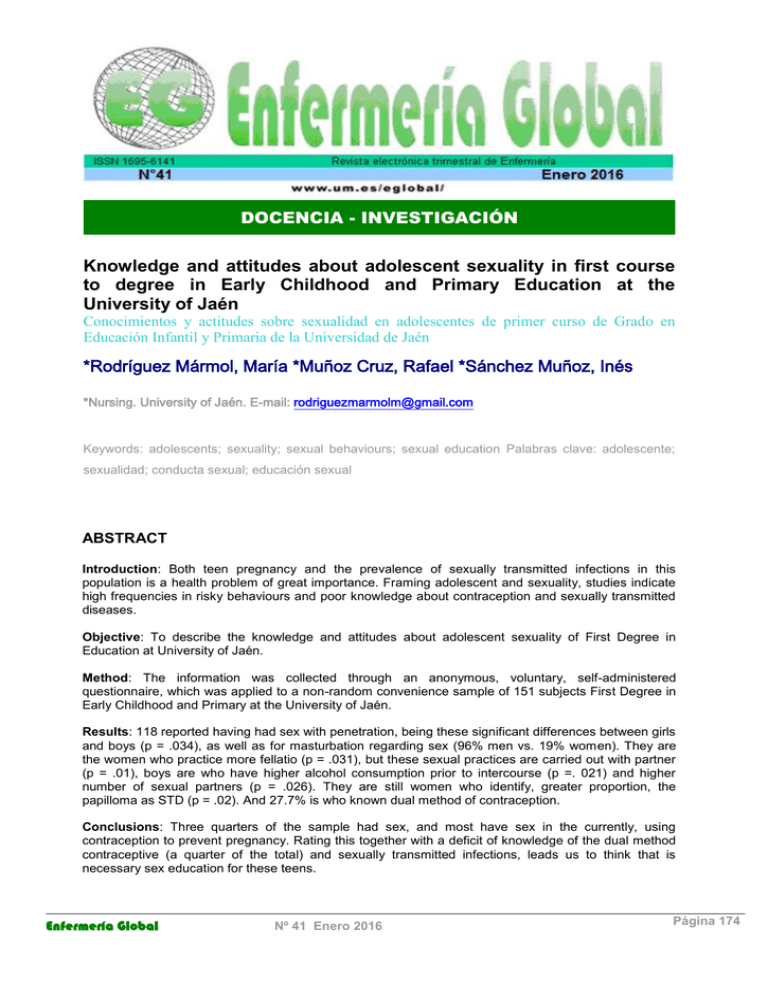
DOCENCIA - INVESTIGACIÓN Knowledge and attitudes about adolescent sexuality in first course to degree in Early Childhood and Primary Education at the University of Jaén Conocimientos y actitudes sobre sexualidad en adolescentes de primer curso de Grado en Educación Infantil y Primaria de la Universidad de Jaén *Rodríguez Mármol, María *Muñoz Cruz, Rafael *Sánchez Muñoz, Inés *Nursing. University of Jaén. E-mail: [email protected] Keywords: adolescents; sexuality; sexual behaviours; sexual education Palabras clave: adolescente; sexualidad; conducta sexual; educación sexual ABSTRACT Introduction: Both teen pregnancy and the prevalence of sexually transmitted infections in this population is a health problem of great importance. Framing adolescent and sexuality, studies indicate high frequencies in risky behaviours and poor knowledge about contraception and sexually transmitted diseases. Objective: To describe the knowledge and attitudes about adolescent sexuality of First Degree in Education at University of Jaén. Method: The information was collected through an anonymous, voluntary, self-administered questionnaire, which was applied to a non-random convenience sample of 151 subjects First Degree in Early Childhood and Primary at the University of Jaén. Results: 118 reported having had sex with penetration, being these significant differences between girls and boys (p = .034), as well as for masturbation regarding sex (96% men vs. 19% women). They are the women who practice more fellatio (p = .031), but these sexual practices are carried out with partner (p = .01), boys are who have higher alcohol consumption prior to intercourse (p =. 021) and higher number of sexual partners (p = .026). They are still women who identify, greater proportion, the papilloma as STD (p = .02). And 27.7% is who known dual method of contraception. Conclusions: Three quarters of the sample had sex, and most have sex in the currently, using contraception to prevent pregnancy. Rating this together with a deficit of knowledge of the dual method contraceptive (a quarter of the total) and sexually transmitted infections, leads us to think that is necessary sex education for these teens. Enfermería Global Nº 41 Enero 2016 Página 174 RESUMEN Objetivo: Conocer los conocimientos y actitudes sobre sexualidad en los adolescentes de primero de Grado en Educación de la Universidad de Jaén. Material y Método: Los datos se recogieron a través de un cuestionario anónimo, voluntario y autocumplimentado, el cual se aplicó a una muestra no probabilística por conveniencia de 151 sujetos estudiantes de primer curso de Grado en Educación Infantil y Primaria de la Universidad de Jaén. Resultados: 118 manifiestan haber mantenido relaciones sexuales con penetración, siendo estas diferencias significativas entre chicas y chicos (p=.034), al igual que para la masturbación en cuanto al sexo (96% de los hombres frente a 19% de las mujeres). También son las mujeres las que practican más el fellatio (p=.031), pero estas prácticas sexuales las realizan con la pareja (p=.01), siendo los chicos los que presentan mayor consumo de alcohol previo al coito (p=.021) y mayor número de parejas sexuales (p=.026). Siguen siendo ellas las que identifican en mayor proporción el papiloma como ITS (p=.02). Y el 27,7% del total conocen del doble método anticonceptivo. Conclusión: Tres cuartas partes de la muestra han mantenido relaciones coitales haciendo uso de anticonceptivos para evitar el embarazo. Valorando esto junto con un escaso conocimiento del doble método (una cuarta parte del total) y de las infecciones de transmisión sexual, nos lleva a pensar como materia necesaria la educación sexual para estos adolescentes. INTRODUCTION According to the World Health Organization (WHO), adolescence is the period of life of the people who starts at 10 and ends at 19 years (1). Many of the serious diseases that emerge in adulthood, are determined by risk behavior in adolescence, as the consumption of snuff, alcohol and / or drug abuse, sexually transmitted infections, sedentary lifestyles and poor nutrition(2). We believe therefore that this is a crucial step with multiple changes, where physiological maturity is acquired before psychosocial. This fact, coupled with the low risk perception of adolescents, can lead to serious repercussions on their health, including sexual health(3). College students who are in their late teens constitute a population at high risk of contracting sexually transmitted diseases because young people tend to have more partners and practice more times casual sex without condoms than other young adults(4). For this reason, the adolescent health is an issue that increasingly generates more interest around the world, due to the better understanding of the particular characteristics of this population and changing conditions of society, which linked to changes in adolescent behaviors, generate new risks to their health (5). Sexual and reproductive health is a major component of overall health and includes both the prevention of unwanted pregnancies, and sexually transmitted infections (STIs)(6), and it has been shown that early onset is associated with a greater number of sexual partners, which significantly affects to the appearance of risky sexual behavior, in early pregnancy and sexually transmitted infections(7, 8). According to the Joint United Nations Programme on HIV / AIDS known as UNAIDS (2012), adolescents constitute 40% of adults those infected with HIV(9). Regarding the degree of knowledge about these infections, he warns of a lack of education among young people, according to the study by Rodriguez and Traverso (10), in which, except in the case of HIV, more than half do not recognize as ITS the gonorrhea, genital herpes and syphilis, in the case of papilloma, chlamydia and trichomoniasis is one of ten that identify it as STIs. Enfermería Global Nº 41 Enero 2016 Página 175 As advanced above, teenage pregnancy is one of the health problems of great importance, due to the many risks that can lead(11). After 70's it has been seen an increase in this indicator, reaching alarming figures at present(12). The main reasons that influence a teenager to get pregnant come to be: early onset of sexual relations, dysfunctional family, low education, magical thinking, fantasies sterility, lack of information, dispute the values of parents and own, sociocultural factors and inadequate sexual education(13). According to Poll of Opinion Institute of Youth (INJUVE) of 2008, 43% of young between 15 to 19 year have had relations complete at least once in life sex. The 89.5% had them before age 17, and 18% did not use condoms in all sexual practices(14). According to Garcia-Vega et al(15), it is the male sex that starts before sexual (14.9 years) relationships, just as it ensures that gender is the highest number of risk behaviors performed. Moreover, in an intervention program in freshmen of Teaching and Education at the University of Cadiz, of which 68.3% reported having a stable partner, a factor to consider as it is related to sexual risk , it is striking that almost 20% of respondents did not use condoms to prevent infection(16). According to Uribe and Orcasita(17), the percentage of respondents who did not use condoms at first intercourse is 34%, and in 28.4% of cases have used ever pill after sex. For these reasons, Barceló and Navarro(18) in their study reflect a failure in the process of educating adolescents and detects inconsistencies in the knowledge, attitudes and practices which have a negative impact. However, these shortcomings do not just happen in our country, is that, according to a study conducted at the University of Social and Preventive Medicine in Lausanne and Zurich, 90% of respondents claimed to have attended a talk on sexual health on their school years, but it was not until they had a chance to talk with friends or with professional of health when associated with a greater awareness about contraception (19). According to recent research, the curricula should consider integrating longitudinal form in adolescent health to avoid or reduce risks posed by adolescents' sexual health. This training requires a multidisciplinary approach, acquiring nursing a key role(20). In general, among young people there is a greater awareness to prevent unwanted pregnancies with oral contraceptives, which to protect themselves from STIs using condoms(4). Affirmation holding the study conducted at a public university in MidAtlantic, in which significant differences were found with regard to receiving sex education and contraceptive use. For this reason, they suggest that young people in college need a better understanding of sexual practices, important step in the development to improve health outcomes(21). Within this context that framed adolescence and sexuality, and based on the current curriculum of the University of Jaen, which do not include sex education in degree programs in Education, it is intended to know the knowledge and attitudes about sexuality in adolescents newly enrolled in that grade, as these are populations at risk and also they are teachers to the future population at risk. MATERIAL AND METHOD Descriptive study of university students enrolled in first grade in school and Primary Education of the University of Jaen. The sample was selected by convenience sampling, being inclusion criteria be under 19 years of age and be the first course of degree in primary education or children Enfermería Global Nº 41 Enero 2016 Página 176 education. Before data collection, the approval of the Bioethics Committee of the University of Jaen was obtained, and reported on the study the Faculty of Humanities and Education Sciences. Data were collected during the month of March through a questionnaire of 32 questions, autocumplimentable, previously used in other similar studies(10) and whose validity was determined by Cronbach's alpha coefficient, determined as good (0.70). The questionnaire was completed anonymously and voluntarily, measuring the dimensions of sex education and sexual behavior of adolescents, using different variables as age, sex, education level of parents, relationship status, sexual orientation, sex education, behavior knowledge about sex and sexuality. Prior to the completion of the questionnaire, informed consent of all participants was sought, in addition to receiving detailed information on the study by the principal investigator, giving option to consult any doubt. The obtained data were processed with SPSS 15, while the EPIDAT 3.1 was used to calculate confidence intervals of frequency measurements. The following statistics operations were used taking into account the objectives of the study: -For the descriptive analysis frequency measures are used for qualitative variables and basic descriptive statistics for quantitative variables, with their respective confidence intervals at 95%. -For the bivariate analysis, the chi-square test of Pearson was used both to study the association between two dichotomous variables to study the association between a dichotomous variable with another policotómica. In some cases, where some of the tables expected frequencies were less than 5, the Fisher exact test was applied. To study the association between a dichotomous qualitative variable and a quantitative, the Student t test was used. The calculations made ,in addition to those named, were the level of statistical significance (p), the effect size (OR) and its confidence interval 95%. The data is represented by tables and charts and were considered statistically significant in those cases where the p value was less than 0.05. RESULTS a) Sociodemographic data It was obtained a sample of 151 university students enrolled in first grade in school and Primary Education of the University of Jaen, of which 36 were men and 115 women, accounting for 23.84% and 76.16% respectively. The age of participants was 18 years. As for the educational level of the parents it was observed that 43% of parents and 44% of mothers had completed primary school or had no education. Of the total sample, 71.5% reported having received sex education, valuing it with an average of 7.5 out of 10, being the sources of information about sexuality and contraception, more preferably found in friends (27%), followed by fathers (25%) and the media (23%), far removed from teachers (7.2%). Enfermería Global Nº 41 Enero 2016 Página 177 b) Sexual behavior The 78.1% of the total had sexual intercourse, with an average age of 16.15 years for the first time, being girls more precocious in these behaviors (16 years versus 16.2). Of all the people who have had sexual intercourse, 76.4% had them with their partner and were the main reasons for falling in love and desire, 58.2% and 27.9% respectively. 12.2% reported using alcohol in the first sexual relationship. And 87.8% reported using some form of contraception that time, mostly emphasizing the male condom, 92.2%. 72.1% said they continue to maintain relations today; the preferred contraceptive in 81.7% of cases is the male condom, highlighting the use of the morning after pill in 26% of cases. It is the main cause of male condom use "to avoid pregnancy" with 56.9%, away from use as a reason to avoid STI (9.5%). For other sexual practices, boys are the ones that indicate a greater proportion masturbating (p = 0.00) and those with them more likely to have oral sex (p = 0.02). Differences in gender for the number of sexual partners were found, being 3 for boys and 1.75 for girls (p = 0.02), and about with who first intercourse remained, women which in greater proportion they had with your partner (p = 0.01) and boys who consumed alcohol, to a greater extent prior to first intercourse (p = 0.02). The following table (Table I) are detailed the relationship of sex with different variables of interest. Table I. Significant differences found by gender for different variables of interest. Outcomes variables Sexual intercourse with penetration Masturbation Women Fellatio Consume alcohol or drugs Current sexual practices Men Chi 2 P value OR CI 95% 93 (85%) 25 (69%) 4,50 0,03 2,56 1,05 – 6,20 18 (19%) 32 (96%) 62,63 0,00 0,007 0,001 –0,06 49 (50%) 9 (39%) 4,67 0,03 2,55 1,07 – 6,07 8 (9%) 7 (28%) 6,17 0,02* 0,25 0,08 – 0,79 75 (85%) 13 (59%) 7,51 0,014* 3,99 1,42 – 11,23 * Calculated with the Fisher exact test c) Sexual education. Overall, of all diseases proposed in the questionnaire, 93% recognized HIV as an STI. Depending on the sexual education received no differences were obtained, but if the poor identification of other diseases is highlighted. The 38% identify the gonorrhea as STI, genital herpes 29%, 17% papillomavirus, syphilis 29%, 11% chlamydia and 4% trichomoniasis. If differences in gender were found, being girls who recognized that further proportion papilloma as STI (p = 0.02). For other diseases did not differences by gender were found. As for the double contraceptive method proved to be unknown in 64% of cases, with no differences between receiving sex education and meet the dual method, as neither was obtained on the basis of sex. Enfermería Global Nº 41 Enero 2016 Página 178 DISCUSSION The sample consisted of 151 first-year students of Degree in Primary Education and Children Education at the University of Jaen, where the majority of subject was female and the age of subjects was 18 years. Of the total sample, a large portion, 71.5% reported having received sex education, being a 7.5 out of 10 the average score they have awarded to the sexual education received. And the main source of information about sexuality becomes friends with 27%, far removed from teachers, 7.2%. With comparable data thrown by Rodriguez and Traverso(10) where the average score was 7.36, almost equal to that of this study, but the main source of information were the parents. These data are consistent with those of other countries, such as those obtained in the work Ottesen et al. (19) in which 90% had received some sex education talk sometime in their life, but it was not until teens talking with friends when acquired greater awareness of risk practices, so that the same source of information was obtained. Regarding ITS, it should be noted that most of the studied sample (93%) identified HIV as sexually transmitted infection, but other infections captured in the questionnaire are not recognized neither at least by the half of the sample, there is great ignorance of these diseases, as stated Barcelo and Navarro(18). If we focus on the percentage of those who have received sex education, we find the same results as Rodriguez and Traverso(10) whose study like this, did not obtain statistically significant differences in any of STIs, but noted low identification of all infections. In the study sample, 78% reported having sexual intercourse once in life, the age of onset being 16.15 years. Comparable to those thrown by the INJUVE (14) in which 89.5% began their sexual intercourse before age 17 data. As for masturbation, it was found that 33% said they have done ever, with an average age of onset of 13.9 years. Similar to those obtained by Rodriguez and Traverso(10) data. Regarding the number of sexual partners you have the adolescents studied, we found an average of 2 sexual partners, which is consistent with Bravoa thrown et al(8), they get a range between 1 and 3 sexual partners. If we refer to other sexual practices, most subjects have made manifest, beyond fondling, masturbation is the partner (61.8%), followed by fellatio and cunnilingus, whose percentage of teens who report having made these practices are lower, 40% and 29% respectively, are still higher than those obtained by Rodriguez and Traverso(10), a difference that could be explained because the study did not cover in the late teens. Following this author, the frequencies obtained as to the person with who made the first intercourse (76% with a partner), why they perform (58% by love) and alcohol consumption prior to the first sexual relationship (12.2% consumed) in both studies are virtually identical. Of all subjects of the sample who have maintained sexual relations, 87.8% used a contraceptive, preferably the male condom (92%), and 7.8% who did not use contraception, but less than comparable data obtained by Frias(2), INJUVE(14) and Uribe and Orcasita(17). As for the reason of contraceptive use, it is striking that 56% is to prevent pregnancy and only 9.5% to avoid an STI, as noted in the V International Conference on Education(16) and the conclusions that come Anton and Espada (4). As for those subjects who reported not using any contraceptive method, 53% did so because they had planned to have sex that day, reason highlights it Rodriguez and Traverso(10) in their investigation. With respect to consumption of the postcoital pill, the study sample referred having consumed in 26% of cases, being 2% lower than the result obtained by Uribe and Orcasita(17). Enfermería Global Nº 41 Enero 2016 Página 179 Regarding the association between receiving sex education and contraceptive use, no statistically significant differences were obtained, as if I got McCave et al(21), whose work suggests that university students need a better understanding of the sexual practices in order to improve health outcomes. It is interesting to note that only 27% of the sample knows the double contraceptive method, superimposable data to those found by Rodriguez and Traverso(10), which suggests inconsistencies in knowledge to that referred Barcelo and Navarro(18). But if we analyze all this data on the sex of the participant, we find that are girls students who considered in higher proportion as STI, the papilloma (p = 0.02), no statistically significant differences in gender for other diseases. No significant differences were found in sex for the double method, a result that did get Rodriguez and Traverso(10) in which the girls had greater knowledge of the dual method (p = 0.02). In the sample studied, women have 2.5 times more likely to have sexual intercourse than men, with a statistically significant difference (p = 0.03), and is more precocious, 16 years compared with boys they begin to 16.20 years. Similar to those obtained by the INJUVE(14) in which 89.5% of those who reported having sexual intercourse once, data did before age 17. However, both Rodriguez and Traverso (10) and Garcia-Vega et al(15) obtained ages of onset less than those in this study, and in both boys are earliest. As for masturbation, they are boys who have more chance of doing it, with significant difference (p = 0.00), as are more precocious (13.56 years compared to 14.57 years), data similar to thrown in the work of Rodriguez and Traverso (10). For other sexual practices, significant differences regarding sex to fellatio (p = 0.03), where are the girls who have the highest proportion such practices were obtained. Women also are in greater proportion had their first sexual relationship with their partner (p = 0.01), no statistically significant differences in the reason which led them to maintain that first relationship. According to Rodriguez and Traverso(10) the reason was the same as that which prevails in this study, infatuation, but in their work if significant differences were found. In terms of consumption prior to first intercourse alcohol, we found a higher proportion of men who consumed (p = 0.02). And the number of sexual partners, (1.75 for women versus 3 for men), significant differences (p = 0.02) were found. As for sex at present, it is women that have the highest proportion (p = 0.01) as is indicated Rodriguez and Traverso(10) in their work. Differences were not significant for the use of contraceptives. According to all the above mentioned, we propose the existence of a possible lack in adolescents studied, as it raised Barcelo and Navarro(18) when they stated that there were inconsistencies in knowledge, attitudes and sexual practices due to failure in the process of education . In our research, men have a higher number of risk behaviors, made similar to that discussed by Garcia-Vega et al(15), is that it is boys who have a higher number of sexual partners and tend to have more sex with friends than girls, which prefer to keep them with your partner. This is relevant, given that, as indicated in the V Congress of Educational Research(16), the fact of not having a stable partner is a sexual risk factor. Enfermería Global Nº 41 Enero 2016 Página 180 CONCLUSIONS According to the results of this investigation and given the low power of the different analysis, we can conclude that adolescents studied showed a deficit of knowledge related to STIs and contraception, as well as presenting sexual behaviors of risk, what greater awareness of this population is believed necessary for the use of contraceptives not only to prevent pregnancy but to prevent sexual infections, and thereby improving health outcomes. Note that one of the limitations that we, along with the characteristics of the type of study and sample selection are that despite being informed every subject of anonymity and voluntariness of the questionnaire not responds truthfully. REFERENCES (1) Organización Mundial de la Salud. Necesidad de salud de los adolescentes. Serie Informes Técnicos. Ginebra: OMS 1977. (2) Frías Osuna A. La cultura y las conductas de riesgo en adolescentes. Granada: Universidad de Granada. 2006. (3) Palenzuela Sánchez Á. Intereses, conducta sexual y comportamiento de riesgo para la salud sexual de escolares adolescentes participantes en un programa de educación sexual. Análisis y Modificación de Conducta 2012;32(144). (4) Antón FA, Espada JP. Consumo de sustancias y conductas sexuales de riesgo para la transmisión del VIH en una muestra de estudiantes universitarios. Anales de psicología 2009; 25(2):344-350. (5) Calero JL, Santana F. Percepciones de un grupo de adolescentes sobre iniciación sexual, embarazo y aborto. Revista Cubana de salud pública 2001;27(1):50-57. (6) Arredondo GP. Embarazo en adolescentes. Estudio sociodemográfico de 218 pacientes. Revista Médica del Hospital General de México2005;68(1):13-19. (7) González E, Montero A, Martínez V, Mena P, Varas M. Percepciones y experiencias del inicio sexual desde una perspectiva de género, en adolescentes consultantes en un centro universitario de salud sexual y reproductiva. Rev Chil Obstet Ginecol 2010;75(2):84-90. (8) Bravoa BN, Seguraa LR, Postigoa JML, Villafruelac JCE, Honrubiac VL, Marchantec MR. Hábitos, preferencias y satisfacción sexual en estudiantes universitarios. Revista Clínica de Medicina de Familia 2010;3(3):150-157. (9) ONUSIDA. Informe de ONUSIDA para el Día Mundial del Sida. 2012. (10) Rodríguez Carrión J, Traverso Blanco I. Conductas sexuales en adolescentes de 12 a 17 años de Andalucía. Gaceta Sanitaria 2012;26(6):519-524. (11) Álvarez Nieto C, Pastor Moreno G, Linares Abad M, Serrano Martos J, Rodríguez Olalla L. Motivaciones para el embarazo adolescente. Gaceta Sanitaria 2012;26(6):487-503. (12) Doblado Donis NI, De la Rosa Batista, Idania, Junco Manrique A. Aborto en la adolescencia un problema de salud. Revista Cubana de Obstetricia y Ginecología 2010;36(3):409-421. (13) Armendiz Ortega AM, Medel Perez BY. Propuesta de intervención para prevenir el embarazo en adolescentes. Synthesis, Aventuras del pensamiento 2010; 55:19-24. (14) Instituto de la Juventud. Jóvenes, sexualidad y salud. Sondeo de opinión. 1ª Encuesta 2008. (15) García-Vega E, Robledo EM, Fernández PG, Fernández RR. Influencia del sexo y del género en el comportamiento sexual de una población adolescente. Psicothema 2010;22(4). Enfermería Global Nº 41 Enero 2016 Página 181 (16) Sexualidad y universidad: un programa de intervención. V Congreso Internacional Virtual de Educación; 2005. (17) Uribe Rodríguez AF, Orcasita Pineda LT. Conductas sexuales de riesgo en estudiantes universitarios de la ciudad de Cali-Colombia. Revista Virtual Universidad Católica del Norte 2011;1(27). (18) Barceló Martínez R, Navarro Lechuga E. Knowledge attitudes and skills in adolescents from the public sector of Barranquilla (Colombia) related to their sexuality. Salud Uninorte 2013;29(2):298-314. (19) Ottesen S, Narring F, Renteria S, Michaud P. Emergency contraception among teenagers in Switzerland: a cross-sectional survey on the sexuality of 16- to 20-yearolds. Journal of Adolescent Health 2002;31(1):101-110. (20) Coleman E, Elders J, Satcher D, Shindel A, Parish S, Kenagy G, et al. Summit on Medical School Education in Sexual Health: Report of an Expert Consultation. The Journal of Sexual Medicine 2013;10(4):924-938. (21) Mccave EL, AzulayChertok IR, Winter VR, Haile ZT. Sexual health behaviors in a random sample of students at a Mid-Atlantic university: 2010-2011. J Community Health 2013;38(2):310-9. Received: October 27, 2014; Accepted: November 21, 2014 ISSN 1695-6141 © COPYRIGHT Servicio de Publicaciones - Universidad de Murcia Enfermería Global Nº 41 Enero 2016 Página 182
